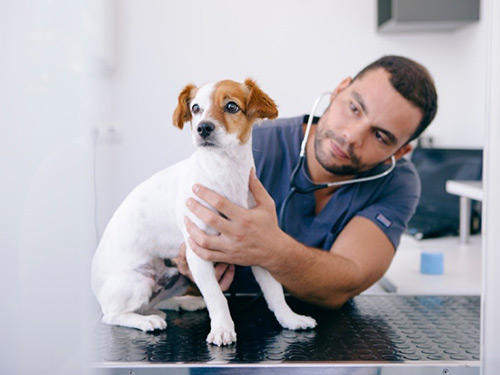 You love animals and have experienced firsthand the joy they bring their human companions. Like humans, however, they require high-quality, compassionate care throughout their lifespan. You can provide exactly that as a veterinary assistant. This important role allows you to quickly enter a compelling field and provide a range of services that promote the health and well-being of animal patients. Veterinary assisting can be highly rewarding, but not just anybody can handle the unique demands of this role. To illustrate the field’s challenges and opportunities, we will provide a detailed veterinary assistant job description — plus valuable insight into how to become a veterinary assistant.
You love animals and have experienced firsthand the joy they bring their human companions. Like humans, however, they require high-quality, compassionate care throughout their lifespan. You can provide exactly that as a veterinary assistant. This important role allows you to quickly enter a compelling field and provide a range of services that promote the health and well-being of animal patients. Veterinary assisting can be highly rewarding, but not just anybody can handle the unique demands of this role. To illustrate the field’s challenges and opportunities, we will provide a detailed veterinary assistant job description — plus valuable insight into how to become a veterinary assistant.
What Is a Vet Assistant?
The term “veterinary assistant” perfectly describes one of the most important roles in modern veterinary care: vet assistants provide several forms of support for veterinarians and veterinary technicians. This encompasses not only administrative assistance, but also, several clinical tasks under the guidance of (and with the purpose of supporting) other veterinary professionals. Vet assistants are charged with helping other members of veterinary teams, with the ultimate goal of improving animal care and reducing administrative burdens.
What Role Does a Vet Assistant Play in the Office?
In general, it is the veterinary assistant’s job to keep clinical veterinary locations (such as offices and hospitals) running smoothly by providing support wherever and whenever it’s needed. Specific vet assistant roles and responsibilities can vary between locations and even on a day-to-day basis, but most serve a few general functions, as described below:[1]
Support the Vet and Vet Technicians
Above all else, it is the vet assistant’s prerogative to provide consistent support to veterinarians and vet technicians. This can take many forms, so vet assistants should understand what other members of the veterinary team require at any given time — and make every effort to fulfill these needs, whether outright requested or not.[2]
Administration Duties
A significant portion of the vet assistant’s day is dedicated to administrative functions that keep practices running smoothly.[3] Examples include:
- Answering phones and emails
- Scheduling appointments or follow-ups
- Submitting patient and client information via practice management software
- Ordering and stocking supplies
Animal Assistance
The veterinary environment can be nerve-wracking for animals and humans alike. Vet assistants make visits less stressful and more enjoyable by providing emotional support and physical comfort. They must be well-versed in techniques for approaching and calming nervous animals — and they should remain calm and collected when these patients are agitated. Animal assistance may also encompass grooming, boarding or, in some situations, restraining patients so they can receive necessary treatments. Humane handling is always essential, as this plays not only into health outcomes, but also, can provide a more positive pet experience.[4]
Vet-Supported Tasks
Vet assistants often provide direct support for veterinarians during complex treatments, such as surgical or dental procedures. As previously mentioned, this may sometimes involve restraining animals but could also mean handing veterinarians’ equipment or even helping to administer microchips, medications or vaccines. In these and other support-oriented tasks, vet assistants must listen to, understand and closely follow instructions to ensure that quality care is consistently provided. They should be able to anticipate veterinarians’ needs and respond accordingly, demonstrating excellent problem-solving skills while remaining within their scope of practice.
Sanitary Jobs
Safe and hygienic veterinary practices limit the spread of disease while also keeping patients more comfortable. Through routine cleaning and organizational tasks, vet assistants ensure a sanitary environment. Key tasks include:
- Sweeping and mopping floors
- Cleaning countertops, surgery tables and sink areas
- Washing, drying and folding laundry such as pet bedding
- Grooming tasks, such as brushing or bathing animals
- Cleaning cages, kennels and runs
- Patrolling cages and kennels throughout the day to verify hygienic conditions
- Sterilizing surgical equipment
Importance of a Smooth Workflow
Veterinarians want to help as many patients as possible, but time and staffing limitations often stand in the way. An optimal workflow allows these hardworking professionals to dedicate more time to assessments, diagnoses and treatments. This also makes veterinary visits easier for patients and their caretakers, who will understandably grow frustrated if they need to spend considerable time making appointments, checking in or simply waiting to meet with veterinarians. Veterinary assistants facilitate a better workflow by handling a variety of tasks that would otherwise occupy the vet’s limited time. This, in turn, keeps the practice running seamlessly so that veterinarians and veterinary techs are better capable of responding to a variety of concerns. We have already touched on the importance of daily rounds, but this is just one of many routine tasks vet assistants take in the interest of improving the function and flow of the entire clinical environment. Strong familiarity with modern tech is also important, as many vet assisting responsibilities involve Cornerstone or other vet-oriented practice management solutions.
Communication Between Vet and Assistant
Because the day-to-day needs and concerns of a veterinary practice can vary so dramatically, there is a clear need for strong lines of communication between veterinarians and their assistants. Veterinarians need to feel confident that assistants will not only understand their instructions and feedback, but also, alert them to emerging concerns. Research indicates that poor communication between staff members can lead to negative outcomes, including client complaints or even animal harm. An integrative review published in the journal BMC Veterinary Research[5] reveals that communication between staff members (such as vets and vet assistants) may have a “huge impact on the clients’ impression of the veterinarians and their perception of their pets’ healthcare.”
Emergency Response
In an emergency situation, mere seconds can make a world of difference, especially if a strong and highly collaborative team of veterinary professionals is on the scene. Vet assistants make up a core part of this team, and while much of their work relates to wellness checkups, there may be a need for veterinary assistant support during urgent situations.[6] Responsibilities may vary on a day-to-day basis but could potentially include:
- Rooming patients, often within intensive care units (ICUs)
- Swiftly and accurately obtain patient health history
- Safely restrain animals when required
- Provide comfort care for patients and empathy for human clients
- Perform basic diagnostic tasks, including radiography
Satisfied Customers
Veterinary assistants are often responsible for building powerful first impressions and also leaving customers with a sense of satisfaction. They interact closely with clients and can bring a great deal of warmth and respect to every conversation. What’s more, these professionals promote swift and responsible service — essential components of client satisfaction. As a report published in VetRecord[7] explains, satisfaction largely hinges on how “clients perceive a particular service from a cognitive, emotional and behavioral perspective and how such perceptions might shape subsequent customer experiences.” Vet assistants can positively impact this perception by promoting the friendly, compassionate and efficient clinical environments that demanding clients expect.
Different Needs for Different Types of Clinics
We’ve touched on the unique role vet assistants play within ICUs and other emergency settings, but this is just one of many ways in which the role may need to be adapted according to the requirements of the facility in question. To that end, vet assistants must develop a thorough understanding of the needs and expectations within the specific clinics or hospitals they serve. They may need to tailor their communication style accordingly. Additionally, administrative tasks may vary based on the volume of clients or associated record-keeping and appointment-setting needs.
What Are the Requirements to Become a Veterinary Assistant?
Veterinary assisting provides an excellent path into the veterinary world without dedicating years to training. That being said, a strong foundation remains important, complete with a thorough understanding of everything from anatomy and physiology to communication and customer service. Curious how to become a veterinary assistant? Follow these steps:
Education and Schooling
The absolute minimum barrier to entry for veterinary assisting: a high school diploma. A college education may not technically be required if you are able to secure sufficient on-the-job training, but employers increasingly cite a preference for assistants who have completed relevant certificate programs.
Pet and Animal Experience
Also not a stringent requirement but strongly preferred: experience caring for animals. Thankfully, this is not difficult for most aspiring veterinary assistants to achieve. Sharing your home with a pet should provide plenty of insight into the physical and emotional needs of both animals and their human companions. As a veterinary assistant, you can draw on past experiences with your beloved pets to inform how you interact with clients and their animal companions.
Prepare for Job Demands
There’s more to veterinary work than simply hanging out with animals. This job can be stressful, boring and everything in between. As you prepare for this role, you need to understand where its unique highs and lows might come into play. Prepare by developing a wide range of critical skills, such as resilience, empathy, communication and time management. These can be developed while you are enrolled in a Veterinary Assisting program — and especially as you seek hands-on training.
Enjoying Your Career
Yes, challenge is built into the very fabric of the veterinary world, but that shouldn’t stand in the way of enjoying your work. If you love animals and are eager to support their health and well-being, you will no doubt find this career path deeply rewarding. The first step to gaining this powerful sense of career satisfaction? Seeking high-level training as a vet assistant. Carrington College’s Veterinary Assisting program will equip you with the wide range of skills to prepare for this role. Reach out today to learn more about this exciting opportunity — and to discover how to become a veterinary assistant.
Sources:
- U.S. Bureau of Labor Statistics. “What Veterinary Assistants and Laboratory Animal Caretakers Do.”
- American Veterinary Medical Association. “Veterinary technicians and veterinary assistants.”
- Donohoe, A. “How to Become a Certified Veterinary Assistant.” Houston Chronicle.
- American Animal Hospital Association. “Humane Restraint of Animals.”
- Pun, J. “An integrated review of the role of communication in veterinary clinical practice.” BMC Veterinary Research.
- Grady Veterinary Hospital. “A Day in the Life of a Veterinary Assistant.”
- Elte, Y. “Client satisfaction in equine veterinary practice: A structured review and qualitative synthesis.” VetRecord.



